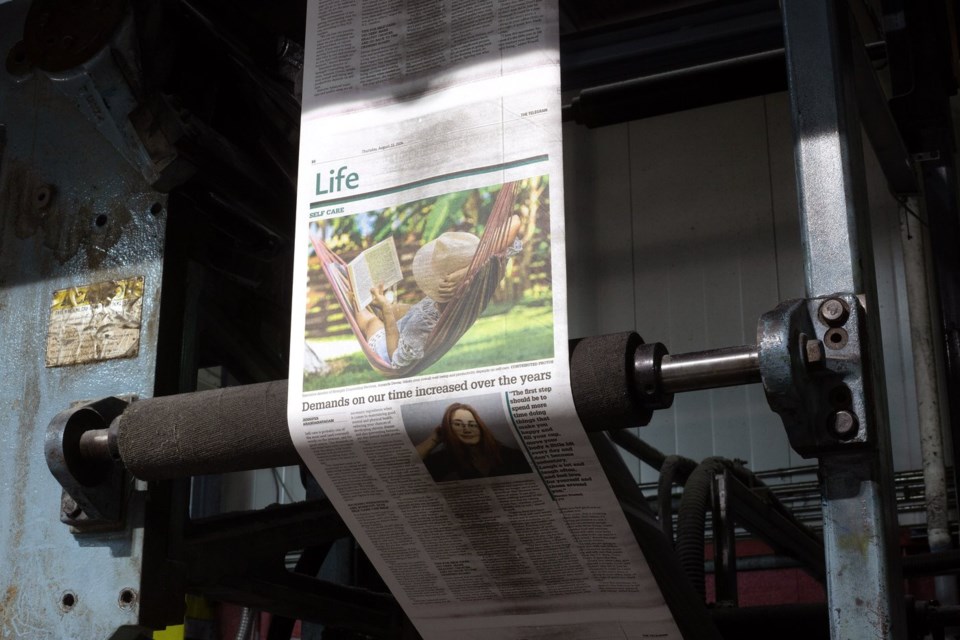ST. JOHN'S, N.L. — The final edition of The Telegram newspaper’s daily print hit the stands in St. John's, N.L., on Saturday, marking the end of a 145-year run and a move to weekly print version with daily stories online.
The People's Paper, as it is also known, was part of SaltWire Network, which was sold to Postmedia for $1-million in an agreement approved earlier this month. The sale did not include The Telegram's printing press — the last of its kind in the province — which has left several other papers scrambling to find a new plan.
On Friday night, the plant fired up for what could be the very last time to print the last daily Telegram. The building is on the market for $5.9 million, and if nobody comes forward to buy it, it will be lost for good.
Nicole Penney, with Memorial University's Folklore and Language Archive, said people have long turned to print newspapers to help them catalogue local life and family stories. The carefully curated folders of documents people bring to the archive are always stuffed with Telegram clippings.
Those folders, and those stories within, help map out the province's social history, she said.
"When someone gets a newspaper, they find a cool story, they clip it out, it has something to do with family, friends, whatever, and they bring it into us. And if it has to do with Newfoundland and Labrador culture, we take it, that's our mandate," Penney said in an interview.
"The option now would be to print the story from online and bring it in. And, like, how many people have a printer at home these days?"
As in the rest of the country, many local and regional newspapers folded across Newfoundland and Labrador in the past decade. When SaltWire purchased The Telegram in 2017 from Transcontinental Inc., it acquired about a dozen other papers operating in communities from Happy Valley-Goose Bay, in Labrador, to Port-aux-Basques, a small former fishing town on Newfoundland's southwest tip.
Only The Telegram and two free weekly papers — the Newfoundland Wire and the Central Wire — were still publishing as of earlier this week, according to SaltWire's website, though the most recent edition of the Central Wire on the SaltWire site was from December 2023.
With The Telegram moving to a weekly print edition, St. John’s joins Fredericton as the only provincial capitals without an English-language newspaper publishing in print at least five days a week.
Meanwhile, Postmedia's takeover of SaltWire Network has rocked several independent publications in Newfoundland and Labrador, including The Shoreline newspaper. The paper serves much of southeastern Newfoundland, including many rural communities along the island's eastern coasts, and it used The Telegram's printing plant in St. John's, which Toronto-based Postmedia didn't buy.
The Shoreline will now have to be printed elsewhere in Atlantic Canada, according to a note on the paper's front page Friday from publisher Craig Westcott.
"We are hoping the change is temporary," Westcott wrote. "We are working hard to re-establish newspaper printing operations in this province, both to print our own newspapers and to serve other small publishers throughout Newfoundland and Labrador."
Joan Sullivan is also racing to find a new printer for the Newfoundland Quarterly, a 123-year-old arts and culture magazine which she edits and runs. She said she worries about the considerable freight costs any publisher will have to bear to have their papers flown or shipped in by sea.
"Those papers started for a reason … people want those newspapers," Sullivan said in an interview. "Print stays put. People save it, people cherish it, and people re-read it."
Sullivan, too, is concerned about the cultural impact of losing a major daily newspaper in print, but also of all the ephemera produced by the plant in St. John's, she said. Those fliers, booklets, sign boards and advertisements all become historical markers and reflections of the values and styles of time they were printed, she added.
On Friday night, some Telegram reporters shared photos on social media of the press in action for what was likely a final run. Some photos showed the pages of the final daily Telegram print edition rolling through the machines. Others showed plant employees carefully inspecting the print.
The next morning, several people at a St. John's Sobeys grocery store had the paper in their cart. Copies were selling quickly, a cashier confirmed.
The bold headline above the fold was readable from across the store: "This isn't the end for us."
The Telegram’s first weekly print edition is expected Friday. Daily news continues online.
This report by The Canadian Press was first published Aug. 24, 2024.
Sarah Smellie, The Canadian Press

